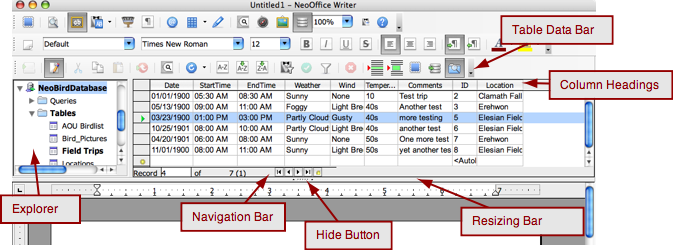|
|
Intro to the Data Source View
From NeoWiki
Reports and Forms are actually Writer documents stored within the odb file of your database. But you can also access the data in registered databases from Writer documents that are not stored within the odb file. This tutorial discusses some of the ways to access and use this data.
Contents |
Registering The Database
In order to access data in from Writer, the database must be registered. When you create a new database, the Database Wizard asks if you want to register the new database. Under normal conditions, you want to check Yes. If you accidently checked No, or if you have received an odb file from someone else, here's how to register the database:
- In the NeoOffice menu, choose Preferences
- Double-click on NeoOffice Base to disclose the sub-categories
- Click on Databases. You will see a list of registered databases.
- Click the New... button. The Create Database Link window appears
- Click the Browse... button and navigate to the database file you want to register.
- If desired, you may give it a Registered name different than the file path.
- Click OK in the Create Database Link window.
- Click OK in the Options-NeoOffice Base-Databases window.
Accessing the Datasource
- In an open Writer, document, click on the Data Sources button on the Standard Toolbar, or go to the View menu and select DataSources. The Data Source View opens just below the toolbars, above your document.
- In the Data Explorer (the left column with a list of data sources), click on the disclosure triangle next to the name of the database file you want to work with.
- Now click on the disclosure triangle next to Queries or Tables under the seleted database name.
- Select the specific Query or Table you want to work with for this document. (e.g. the All Sightings query). wait while the data loads. Note that the more complex the query, the longer you will need to wait. (The wait time may also be affected by available memory, CPU load, and processor speed).
- Make sure that the Table Data Toolbar is visible at the top of the Data Source View. It is the toobar that is circled in the image below:
- If this toolbar does not, appear, you will need to move or rename your preferences folder, as there does not seem to be any other way to turn it on from within the program. See the articles on corrupted preferences and Salvaging Settings from Preferences for directions. When I encountered this problem, I narrowed the troublesome spot down to the registry folder. Instead of moving the entire preferences folder, you might try moving/renaming just the registry folder. Note that you will lose data source registrations if you need to do this. See Registering the Data Source.
- Due to the fact that this toolbar cannot be turned back on without moving preferences, DO NOT close the Table Data toolbar.
Editing Data in Data Source View
Filtering Data in Data Source View
Sorting Data in Data Source View
Inserting Fields from the Data Source
Adding Fields in the flow of your document
Quickly Creating a Writer Table
Using the Next Record Field
Issues with Image Fields
Creating Forms in Writer Documents
Forms are not limited to those stored within an odb file. You can also create a form in an "independent" or "external" Writer document. When working with forms, you do not use the Data Source View.
- Make Sure that the Form Controls and Form Design toolbars are visible. If they are not, go to the View menu, choose Toolbars and select the needed toolbars.
- Click on the Form button. The Form Properties window should appear.
- You can also reach the Form Properties window by clicking on the Form Navigator button, control-clicking on the name of the form (most likely Standard), and choosiing Properties.
- Click on the Data tab.
- Click on the ... next to Data Sources and browse to locate the desired data source
- Set the Content type for Table or Query, depending on your source. Those familiar with SQL can also choose SQL Command
- Select the desired Query or Table from the Content drop-down
- Adjust other settings as desired, and close the Form Properties window.
From this point on, editing forms in an independent Writer document should work the same way editing forms stored in he odb file do.
Related Wiki Links
Using the Mail Merge Wizard
Various Form Tutorials in the To Base and Back Again series.

